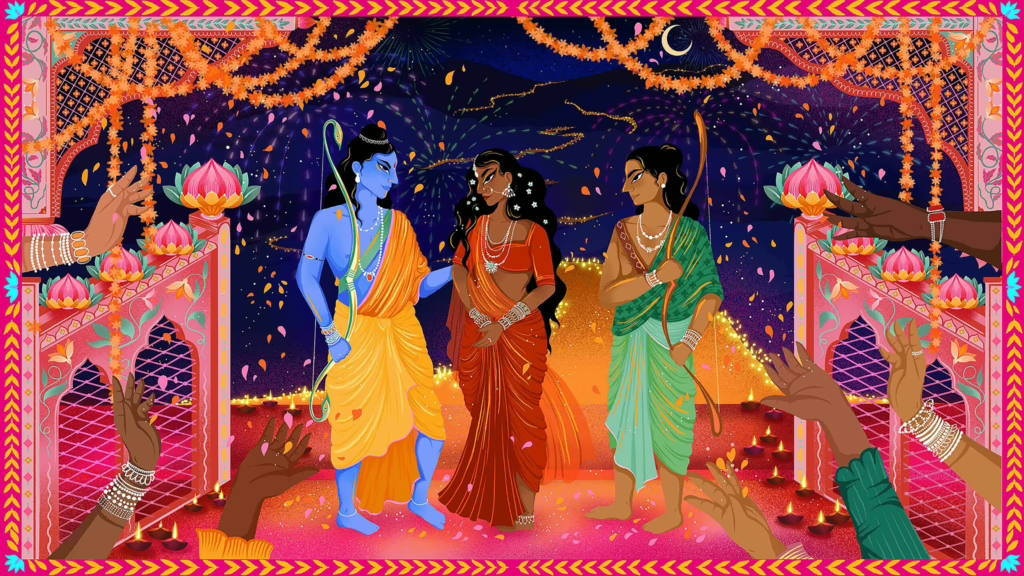For teachers, pupils, parents and anyone else involved in the education system, September always feel more like a new year than New Year. New school uniform, new shoes, new pencil case (or is that just us?), new teachers for the children, new children for the teachers. And the promise that this year, you’ll keep up with the marking.
Then before you know it, October arrives with darker evenings and – ugh – darker mornings, and you’re already behind with the marking. Never mind, it’ll soon be half term, and you’ll have the chance to catch up.
And there is light in the darkness! At this time of year, there are lots of festivals and events that use light or fire (or both) to hold off the night.
The Hindu festival of Diwali begins of the 20th October this year, and on the 21st, Sikhs will be celebrating Bandi Chhor Divas – and we have got films about both of them!
Diwali – or Deepavali – means “row of lights”, and it happens at the new moon that marks the end of the Indian month Ashwin and the beginning of Kartik, which is also the Hindu New Year. It’s a time to celebrate the victory of good over evil, light over darkness and knowledge over ignorance. The Goddess Lakshmi is welcomed to people’s homes with rangoli patterns on the doorsteps and diya lamps in the windows. Hindus hope that she will bring them good luck for the coming year.
One of Lakshmi’s avatars is Sita, wife of Rama (who is an avatar of the God Vishnu – it gets complicated). So at Diwali, the story of the Ramayana is told – how Rama and Sita were banished from their home for 14 years, how Sita was kidnapped by Ravana the Demon King, and how Rama rescued her with the help of his half-brother Lakshmana, and Hanuman the monkey hero and his simian army. Eventually, Rama and Sita returned home, and their way was lit by hundreds of thousands of diyas. Today, to commemorate the occasion, houses, mandirs and shops are decorated with lights, and fireworks are set off to brighten the night sky.
Bandi Chhor Divas means “The Day of Liberation”, and Sikhs get together at the Gurdwara – the Sikh Temple – to worship, to eat, and to set off fireworks. Bandi Chhor Divas is celebrated at the same time as Diwali, and the two festivals are sometimes mixed up, but for Sikhs, the day marks a very special moment in their history when Guru Hargobind – the sixth of the ten Gurus – was released from prison. He’d been locked up in the Gwalior Fort with 52 Hindu princes, but when the time came for him to leave, he refused to go unless the Hindu princes were also given their freedom. The Emperor Jahangir didn’t want a Sikh revolt on his hands, so he came up with a compromise: Guru Hargobind would be released, and as many Princes who could hold on to his cloak as he passed through the narrow gateway of the fort would be allowed to leave with him. So Guru Hargobind walked out, followed by all 52 of the princes, who were each holding on to a tassel of an enormously long and flamboyant cloak that the Guru had got specially made for the occasion.
As night falls, Sikhs light diyas to celebrate Guru Hargobind’s return home, and the victory of light over darkness. Then it’s time for fireworks!
Over the last couple of years, the TrueTube team has been slowly adding to our Festivals series of films, but it’s a slow process. We send a small crew to film a festival as it happens, and then edit the footage so it’s ready for the same festival the following year. Even with all that time to play with, we still manage to be working on the films right up to the deadline!
In the case of Diwali and Bandi Chhor Divas, we wanted to do something special to help tell the stories behind them, but we didn’t have the budget for full-blown animations. However, some of the TrueTube team are old enough to remember Jackanory, which gave us an idea. For all the Gen Zs and younger Millennials out there, the BBC’s Jackanory was the CBeebies Bedtime Stories of its day, but aimed at older kids. An actor or celebrity read a story to the audience, or even whole books over several episodes, and they were helped along with detailed pictures from which the camera would pick out characters and objects as they were mentioned by the narrator. It was a simple but brilliant format that lasted for over 30 years.
If the greatest form of flattery is imitation, then we are very good at flattery.
We found an artist known as Kushiaania via her social media accounts, gave her descriptions of the pictures we were after and – wow! – we were blown away by the gorgeous art she sent back. It was a modern take on traditional Indian illustrations – flat perspective, incredible detail, and rich colours. If you haven’t seen the films, we urge you to take a look, if only for Kush’s art (she was so good we got her to illustrate the story of Vaisakhi as well – but save that for April).
We encourage you to use our films on Diwali and Bandi Chhor Divas in your assemblies, form times and lessons.
Try these discussion starters:
- How is light used in the festivals? What does it symbolise?
- What are the similarities and differences between Diwali and Bandi Chhor Divas?
- Why do you think there are so many similarities between the two festivals?
- How is light used in festivals from other religions?
- Why is light such a common symbol in so many religions and cultures?
And this could lead into some artwork, inspired by Kushiaana’s pictures. Try turning the Ramayana into a comic book, draw a rangoli pattern for Lakshmi, or design a cloak for Guru Hargobind!
Whatever you do, bring some light and colour into these darkening days…







